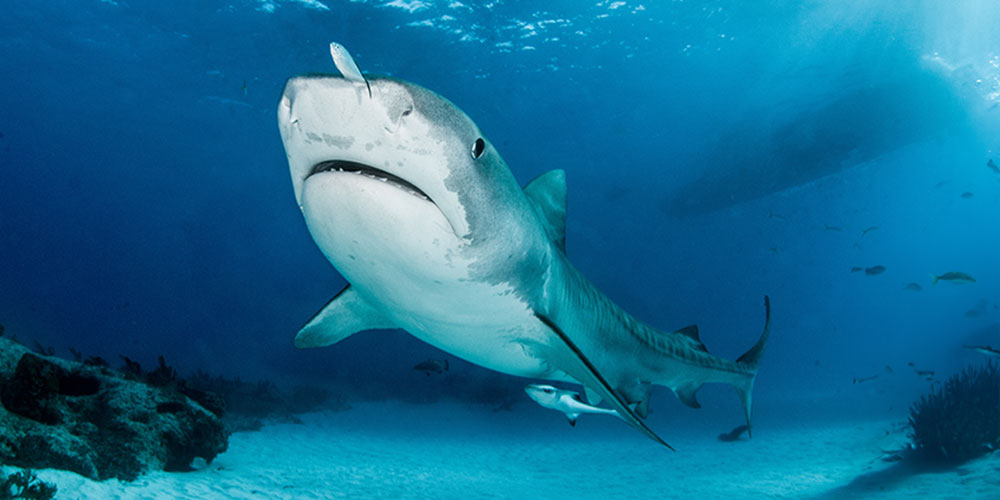Dangerous demand: how humans threaten biodiversity
The shark has survived numerous environmental disasters, but now it may be losing the battle against its most dangerous rival: the human being. A new economic analysis shows the conditions under which high demand can lead not only to the extinction of a single species, but also to a progressive, accelerating mass extinction.
19 August 2024 | Céline Emch
According to the Living Planet Index LPI, we are in the midst of a biodiversity crisis. In just 50 years, the biodiversity index has shrunk by 69% and biologists are already talking about the sixth mass extinction. Earth’s history has witnessed a drastic loss of species five times to date, caused by meteorite impacts, ice ages and changes in climate. The current mass extinction would be the first caused by humans.
In the face of this apparent dramatic decline in biodiversity, Professor Rolf Weder from the University of Basel and Professor M. Scott Taylor from the University of Calgary, Canada, set out to research the economic causes of extinction. In the Journal of Economic Perspectives, they draw conclusions about how a mass extinction can occur, supported by both theory and empirical findings.
From buffalo hide to shark fin
While extinction is a natural process that can affect any species, advances in technology, population growth and rising incomes increase human demand, which can make a species vulnerable and rapidly push it to the brink of extinction.
One historical example of this is the killing of 10 to 15 million prairie buffalo in the United States in the late 19th century. Following an innovation in the European tannery industry, American buffalo were shot exclusively for their hides. These hides were exported to Europe for processing while the meat and bones were left to rot on the prairie. After ten years, there were only about 100 specimens still alive. “What saved the last buffalo was the fact that, with cowhide as an alternative, prices for buffalo hides failed to spike, so hunting the few remaining buffalo became an unattractive option,” explains Weder.
Today, sharks suffer a similar fate; they are killed in the world’s oceans and their fins are exported to Asia, where they are primarily used for shark fin soup in China, Singapore, Malaysia and Taiwan.
The basics of extinction
Rolf Weder and Scott Taylor use their analysis to assess this type of trend. Data from the LPI and the Red List of Threatened Species issued by the International Union for Conservation of Nature IUCN provides distinct evidence of a continuing and accelerating decimation of all listed shark species.
Economic theory helps us to understand the interrelationships behind this phenomenon. Because shark fin consumers not really care what type of shark ends up in their cooking soup, sharks above a certain minimum size are hunted everywhere and their fins are sold. Without restrictions on hunting, it is the species with slow reproduction rates that are initially pushed to the brink of survival. For a while, the fast multiplying species can still hold their own. Weder adds: “The higher growth rate of the remaining species can save them from extinction if it compensates for demand; however, demand for the fast-replicating sharks is increasing as the slow-replicating ones are decimated and, given their falling population, they generate a continually declining number of offsprings.”
The deadly duo for biodiversity
The analysis of the two researchers reveals that the combination of concentrated demand for the remaining species and their habitat loss can lead to progressive mass extinction. The interaction of these two forces can not only wipe out all species of a specific family, but accelerate the extinction of one species after another. The authors show that this predicted relationship matches the extinction risks of individual shark species published by the IUCN over time.
Political hesitation is the enemy of endangered species
Despite alarming data on the decline in shark populations, policy makers have been hesitant in responding to demands to protect the animals. The international CITES agreement, which regulates cross-border trade in endangered species, protects only a fraction of the endangered sharks. Of the 153 highly endangered species listed by the IUCN, trade is regulated for only 74 – and in most cases only since 2023. There is no species of shark subject to a strict trading ban.
Based on their findings, Weder and Taylor are proposing an automatic restriction or ban on international trade for entire genera or families – rather than just individual endangered species – once species reach a certain risk of extinction and the interrelationships outlined above apply. This automatism would reverse the political process; instead of adding species to the list, CITES members would have to vote on deletions or exemptions.
The researchers also want to see the Living Planet Index professionalized. Weder says: “Huge sums of money are spent on saving individual, endangered species, but the fundamental work of collecting complete, regular data on less charismatic species and appropriately summarizing individual observations into an overall index is neglected. Ultimately, we can only save what we count.”
Original publication
Taylor, M. Scott and Rolf Weder:
On the Economics of Extinction and Possible Mass Extinctions
Journal of Economic Perspectives (2024), doi: 10.1257/jep.38.3.237



